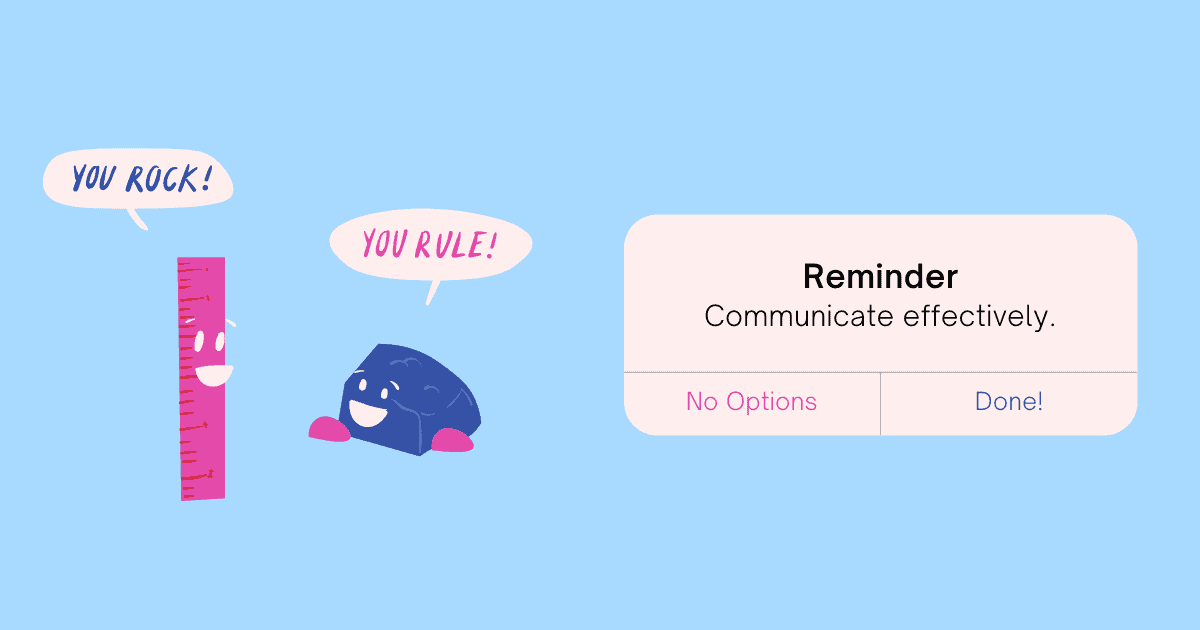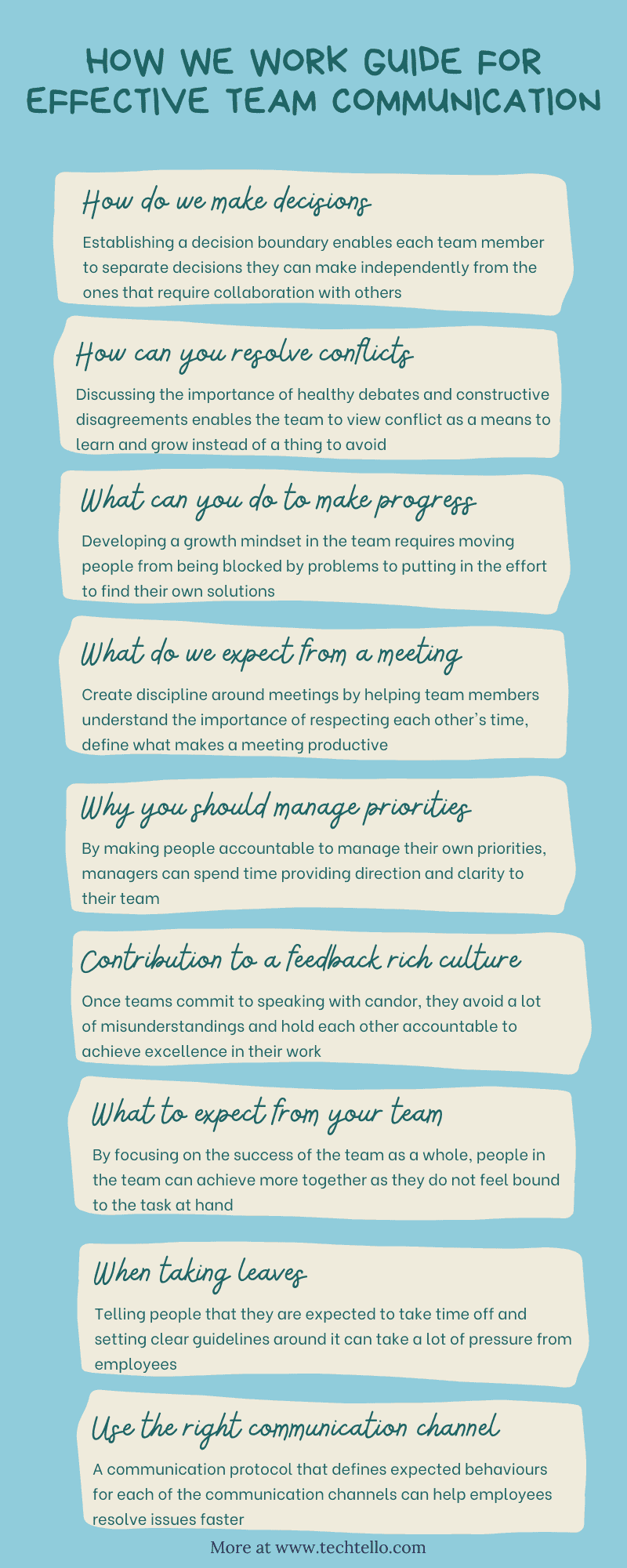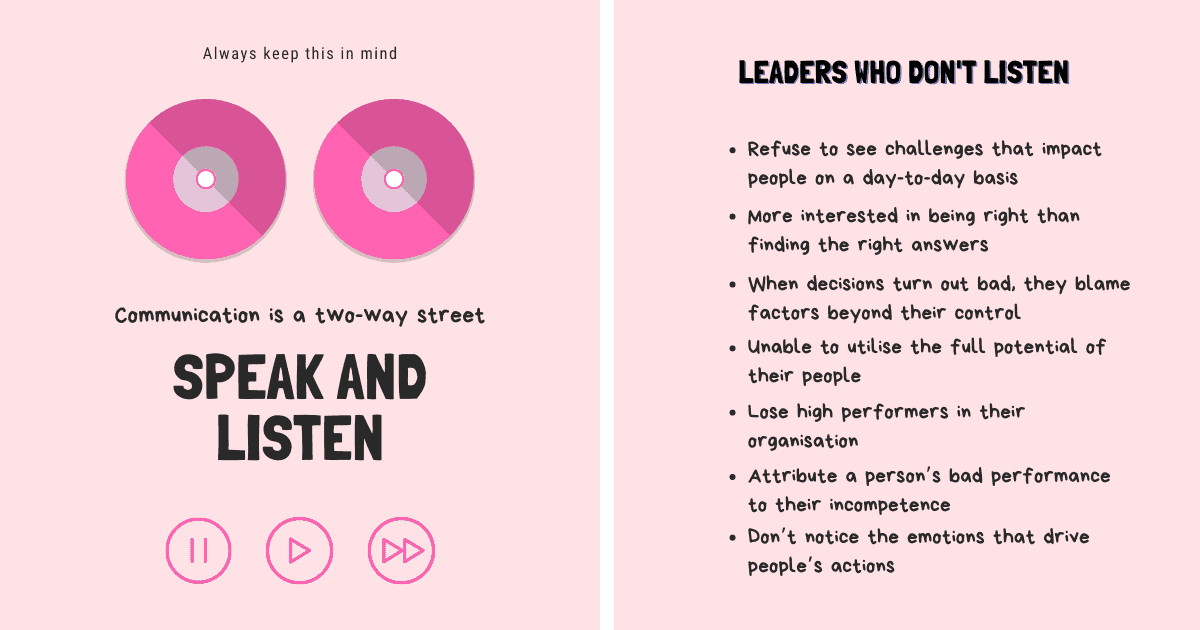Managers, Do You Have A Language For Your Team?

Navigating the culture of a team is more art than science. Unspoken expectations, individual preferences, past experiences, sense of shared purpose and relationship between team members dictates a large part of how a team communicates and collaborates.
Without stating, each team develops its own implicit language that determines:
- How decisions are made in the team
- Whether team members feel safe to speak up
- What do people in the team do when they are blocked
- Who is responsible for resolving conflicts
- Do people work on tasks that adds value or waste time in doing inconsequential activities
- How do they feel when seeking help from others
- What’s their sense of urgency, things that require their attention
- Are people in the team more reactive or proactive
- Do people respect their own time and those of others
- Do they take responsibility for their actions or blame others
- How is knowledge shared between team members
- Do they operate from a place of ego or a desire to contribute value
Without defining what good team communication looks like, people in the team either adapt to existing practices and go with the flow without questioning their effectiveness or feel frustrated when others ignore their suggestions and shut them down for trying to bring about positive changes in the way people in the team communicates.
Think about your own team for a while – what’s your contribution to the communication structure of your team, what assumptions did you make, how did you separate what’s acceptable from what’s not and what problems do you see in the current way of working together?
Letting every team member develop their own communication playbook is not only inefficient, it leaves a lot to interpretation. Difference of opinion is healthy when people come together to resolve these differences and agree on a common set of communication values else it can lead to misalignment of expectations, unnecessary conflict, stress and anxiety in the team.
What seems right to you may be considered wrong by others, what seems natural to you may be uncomfortable to them and what seems efficient to you may not appeal to your team:
- You think a slack message is a better way to communicate for all types of issues, while others prefer using emails for non-urgent communication.
- You may be comfortable in resolving your own issues and do not hesitate to approach a member from another cross functional team while some of your team members feel it’s their manager’s job to resolve all conflicts that cross team boundaries.
- You like to make decisions independently or prefer a small group of people when setting up a meeting while others may invite everyone in the team even for making small decisions.
“Not finance. Not strategy. Not technology. It is teamwork that remains the ultimate competitive advantage, both because it is so powerful and so rare…If you could get all the people in an organization rowing in the same direction, you could dominate any industry, in any market, against any competition, at any time”, says Patrick Lencioni in The Five Dysfunctions Of A Team.
And how do you build such a team?
A common language, an agreement on how to communicate effectively is the binding force that can bring people in a team together through shared understanding. A “how we work” guide is useful to reinforce good behaviour in the team, hold others accountable and spend time in doing real work as opposed to resolving issues that creep up due to lack of proper communication guidelines.
How we work guide for effective team communication
While it may seem like it’s the managers’ job to define a template for effective team communication, creating it isn’t their responsibility. They should act as a facilitator to provide context to their team on the importance of establishing this language, ask them to think about the common communication challenges and then collaborate on ideas to work better together.
Once people in the team agree on communication methods, it can then be compiled into a “how we work” guide. With team members involved in the decision making process, they will buy-in to these ideas and will be more willing to put it into practice. Simply telling people what to do even when it’s the right thing to do hardly works.
A good communication playbook for your team should cover:
1. How do we make decisions
Establishing a decision boundary enables each team member to separate decisions they can make independently from the ones that require collaboration with others – a manager, another team member or a cross functional unit.
A lot of bad decisions in the team can be avoided by following a good decision making process. It empowers the team to make their own decisions while acknowledging the risk and responsibility that comes with freedom. When people accept responsibility for their own decisions, they are more likely to work hard in getting it right.
Decision making template
Process for making decisions:
- Who needs to be involved for different types of decisions
- What data needs to be gathered
- Who’s responsible for the outcome
- How decisions must be documented
- Who needs to know
E.g. A product design change must be presented in a document, reviewed and signed off by senior engineers in the team. Person doing the change should take complete responsibility for driving it end-to-end. Once a decision has been made, the change must be communicated in a weekly change summary email to the team. If the change crosses team boundaries, it’s functional impact must be evaluated with other teams and a proper action plan must be put in place to collaborate with other teams.
In case of an irreversible decision, the guideline must state the manager and possibly other leaders in the organisation must be involved. Manager is responsible to identify the person who will be charged with leading this change and must review the strategy and tactics to put this decision to action.
In summary, effective team communication starts with a good decision making process in which team members have clarity on the process and take responsibility for their decisions.
2. How can you resolve conflicts
Discussing the importance of healthy debates and constructive disagreements enables the team to view conflict as a means to learn and grow instead of a thing to avoid. “Difficult conversations are almost never about getting the facts right. They are about conflicting perceptions, interpretations, and values”, says Douglas Stone in Difficult Conversations.
When people in the team learn to approach conflicts with a desire to establish a shared understanding, the mindset shift happens from my solution, your solution to finding the right solution. It doesn’t take away the discomfort that comes with expressing disagreement, but it does provide the courage to embrace the uncertainty and unknowns involved in resolving the conflict.
Mindset to resolve conflicts
Lean into the conflict with vulnerability:
- Separate your idea from your identity
- Identify your motive to resolve the conflict, what is it that you want to achieve
- Speak your mind, but listen to others as well without judgment
- Validate your thought process by using different mental models
- Instead of being right, try to do the right thing
- If you are wrong, acknowledge it and then show curiosity to explore
- Instead of being dissatisfied, use your frustration to invent
In summary, with the right mindset, people in the team can learn to resolve conflicts and communicate with the desire to add value.
3. What can you do to make progress
Developing a growth mindset in the team requires moving people from being blocked by problems to putting in the effort to find their own solutions. Once team members develop a growth mindset, they see value in trying harder, implementing new strategies, facing challenges and learning from their mistakes.
The clear expectation to take responsibility for their own progress prevents them from passing blame and feeling helpless to forging their own path. Carol Dweck, an American psychologist says “No matter what your ability is, effort is what ignites that ability and turns it into accomplishment.”
Unblock yourself checklist
Instead of blaming others for your problem, own it:
- Go beyond the symptom to identifying the root cause. What’s actually blocking you
- List down all possible solutions you can think of that can help you move forward. Set a reasonable time limit to try each one out
- After trying everything if you are still blocked, reach out to people within your team or outside who can guide you
- Keep people who are dependent on your progress informed. No one should be required to pull information from you. It’s your responsibility to push information to all key stakeholders who are impacted by your progress
In summary, effective team communication isn’t about unblocking others. It requires taking responsibility for your own progress.
4. What do we expect from a meeting
We all know what’s the biggest productivity killer at work. When people in the team don’t learn to manage their time well, they storm from one meeting to the next without creating value. Unorganised meetings without clear agenda and action items also distract people from doing real work.
Create discipline around meetings by helping team members understand the importance of respecting each other’s time, define what makes a meeting productive and explore alternative ways to make decisions.
Running effective meetings
Use time wisely:
- Think about the purpose of the meeting. Do you really need a meeting or is it something that can be resolved over an email or through a one-on-one interaction
- Identify the people who need to participate. You don’t need everyone, only those who will add value to the conversation or who are impacted by its decision
- Clearly state the agenda at the beginning of the meeting
- Steer the meeting in the right direction, encourage diverse viewpoints, do not let anyone hijack the discussion and ask good open ended questions to make a decision
- Define clear actionables at the end of the meeting – who is going to do what, by when.
In summary, meetings aren’t the only way to reach alignment. There are alternative ways to communicate and reach a decision.
5. Why you should manage your own priorities
Conflicting priorities, inconsequential activities and urgent situations all demand attention. Without someone prioritising them right, they eat away into the team’s ability to achieve significant outcomes.
Stephen R. Covey says in The 7 Habits of Highly Effective People “How different our lives are when we really know what is deeply important to us, and keeping that picture in mind, we manage ourselves each day to be and to do what really matters most.”
By making people accountable to manage their own priorities, managers can spend time providing direction and clarity to their team. When people in the team understand their goals and how those goals fit into the overall strategy of the organisation, they can decide where and how to spend their time.
Prioritising it right
Add value to work:
- Make sure you have complete clarity on the direction of your team and can relate how your goals connect to the success of your team. Ask questions.
- Say no to activities that does not align with your goals
- Do not work only to please others, do work to create value
- Make sure you understand what’s truly urgent and requires you attention. If you keep reacting to urgent work, you will never be able to get important stuff done
- When you struggle with conflicting priorities, involve the right people to help you decide
In summary, you are not communicating well if you can’t take care of your own priorities.
6. Your contribution to developing a feedback rich culture
When people in the team communicate with the intention to learn and grow, they do not hesitate to receive and give feedback. This creates a feedback rich environment in which people constantly think about “how can we work better, how can we improve together”.
Once teams commit to speaking with candor, they avoid a lot of misunderstandings and hold each other accountable to achieve excellence in their work. They do not rely only on their manager, but rather use every opportunity to seek feedback. Though it’s hard to receive criticism, they know it’s the only way to improve.
Sharing feedback
Commit to learning:
- Share constructive criticism to help the other person improve
- Seek feedback for your own work
- Keep your feedback specific
- Make the feedback about the work, do not make it about the person
- Work on improving how you deliver feedback
In summary, take responsibility for improving your team communication. Share and seek feedback.
7. What to expect from your team
Successful teams work together as a unit. It does not mean that team members pick up the slack when others aren’t doing their job properly or hide their mistakes. It means supporting each other towards a common goal.
By focusing on the success of the team as a whole, people in the team can achieve more together. They do not feel bound to the task at hand and find freedom in contributing above and beyond their assigned responsibilities. As Daniel Pink says in Drive “Human beings have an innate inner drive to be autonomous, self-determined, and connected to one another. And when that drive is liberated, people achieve more and live richer lives.”
Working with the team
Connect to build trust:
- Take initiative to start a conversation with your team members – do coffee chats, go out for lunch
- Be polite and respectful, never badmouth others
- Always appreciate them for helping you ang giving you their time
- Share knowledge with your team members
- Build new skills by showing curiosity and asking questions
- Think of your goals and success as a team
In summary, your team is your support structure. Make it strong.
8. When taking leaves
Telling people that they are expected to take time off and setting clear guidelines around it can take a lot of pressure from employees. Most of the time people aren’t sure about how to behave when they are on leave – should I be checking my email, should I respond to that message, can I miss my weekly call, what should I do with my clients and so on.
Being on all the time and not taking the time to switch off can prevent them from doing meaningful work, spend quality time with their family and give space to their brain to form new connections required for creative output.
When you aren’t around
Make it count:
- Inform your manager, clients and key stakeholders who work with you
- Complete your commitments before going on a leave unless it’s an unplanned one
- If you have taken a sick leave, prioritise your health
- If you have taken an emergency leave, you are not expected to respond
- If it’s a personal vacation, disconnect and enjoy. You deserve time off
In summary, people aren’t expected to take leave and still work. Replying to emails and messages even when you are out isn’t healthy.
9. Learn to use the right communication channel
Sending emails to employees for urgent issues and expecting them to respond in real time is highly unproductive. It’s equally demanding to use real time communication tools like slack when the discussion is better suited using an asynchronous communication medium like email. Even calling people directly for small things distracts them from focusing on their work.
The biggest communication problem at work is people don’t know which channel is better suited for different kinds of issues. Without clarity, they use what seems more convenient to them in the moment.
A communication protocol that defines expected behaviours for each of the communication channels can help employees resolve issues faster, stop wasting time by constantly checking emails and responding to every ping and focus on getting real work done.
Using communication channels
Use right channel for communication:
- Asynchronous communication tools like emails are best for non-urgent discussions where you can wait for the other party to respond. Acknowledge or respond within 24 hours
- When something requires immediate attention or you need clarification to move forward use real time communication like slack or any other internal chat app
- For resolving urgent issues directly call the person
Summary:
Develop a language for your team, a “how we work” guide for effective team communication:
- How do we make decisions: Define the decision boundary for decisions they can make independently from ones that require collaboration.
- How can you resolve conflicts: Use the right mindset to lean into the conflict with the desire to establish a shared understanding.
- What can you do to make progress: Do not blame or feel helpless, forge a path to your own progress.
- What do we expect from a meeting: Take control of meetings and use them to add value and not suck away into your time.
- Why you should manage your own priorities: Take accountability to manage your own priorities. Learn to say no.
- Your contribution to developing a feedback rich culture: Constructive criticism is the only way to learn and improve. Give and receive feedback at every opportunity.
- What to expect from your team: You don’t need permission to take responsibility. Help your team succeed.
- When taking leaves: When taking time off, don’t think about work. Make it count.
- Learn to use the right communication channel: Know the right medium to communicate for different types of issues.






























